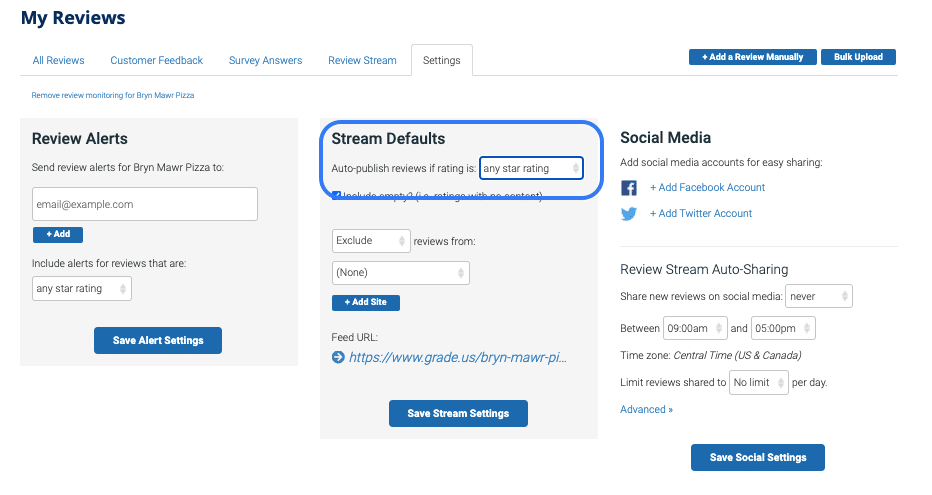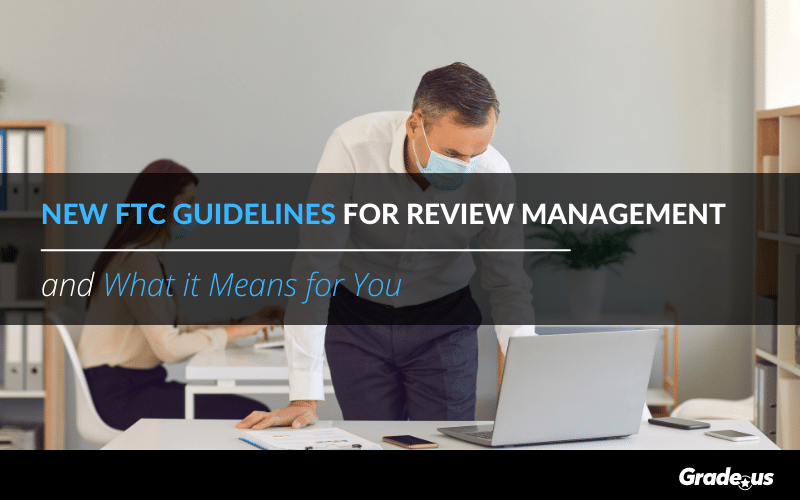Updated 2/23/2022
The Federal Trade Commission recently sent out updated guidelines and principles for businesses, marketers and review management platforms, such as Grade.us. We want to make sure our partners are aware of the changes and taking steps to follow the guidelines.
In this blog post we will walk through best practices for your online review management strategy.
So what are these guidelines and what is being done to follow them?
Best practices for review generation or solicitation
Best practice when it comes to asking for reviews is to ask ALL your customers and give everyone an equal chance at leaving a review. If your goal is to build a better business, you need to know what all your customers think. Do not be selective about who you ask for a review. And don’t make it more difficult for some customers to leave a review than others.
- Don’t ask for reviews only from people you think will leave positive ones.
- If you offer an incentive to consumers for leaving a review, don’t condition it, explicitly or implicitly, on the review being positive. Even without that condition, offering an incentive to write a review may introduce bias or change the weight and credibility that readers give that review. For these reasons, some platforms have prohibited incentivized reviews altogether or have established mechanisms for labeling them.
- Don’t prevent or discourage people from submitting negative reviews.
What we are doing
Grade.us has encouraged unbiased review collection that includes ALL customers. For instance, you can connect your CRM to make a seamless process where all customers in your database are sent a review request.
At the moment, Grade.us has everything you need to be within these basic principles. However, to make sure our solution, and therefore our customers, are in compliance with these guidelines we have made a few adaptions to the Review Funnel.
Within the Review Funnel Grade.us customers can display a personalized message to customers who either leave a positive or negative rating. Be sure to thank those on the Positive screen, and offer a chance to help on the Negative response. Regardless of their initial rating customers will be offered your selected Review Links. We have enlarged the “Send Feedback” button so if customers prefer to leave you direct feedback they can more easily find that option. This will make sure our partners are following FTC guidelines and best practices.

What customers should do
Within your Review Funnel settings, set the star rating threshold to “ALL.” This ensures all customers, regardless of their initial rating, will be able to leave a review on other review sites.

Grade.us does not recommend businesses incentivize customers for leaving reviews. An incentive can appear to sway the reviewer into leaving a positive review. This is not considered a best practice for review generation.
Also, do not ask employees or family for positive reviews, per the FTC guidelines and best practices. Doing so is a form of selecting reviewers who are more likely to leave a positive review.
Publication of reviews and feedback
Another important element of the FTC guidelines is around the publication of reviews.
The FTC believes in these basic principles:
- Publish all genuine reviews and don’t exclude negative ones.
- Don’t display reviews in a misleading way. For example, it could be deceptive to feature the positive ones more prominently.
- If you display reviews when the reviewer has a material connection to the company offering the product or service — for example, when the reviewer has received compensation or a free product in exchange for their review — that relationship should be clearly and conspicuously disclosed.
- Clearly and conspicuously disclose how you collect, process, and display reviews, and how you determine overall ratings, to the extent necessary to avoid misleading consumers.
- Have reasonable procedures to identify fake or suspicious reviews after publication. If a consumer or business tells you a review may be fake, investigate and take appropriate action. That may include taking down suspicious or phony reviews, leaving them up with appropriate labels, issuing an alert about them, and addressing the issue with those responsible for it.
What we are doing
Grade.us recommends a business show all reviews, regardless of star rating. More transparency builds more trust and a trusted reputation is more important than a 5-star rating.
In fact, studies have shown that businesses whose total number of reviews are 15-20% negative average 13% more annual revenue than businesses whose reviews are 5-10% negative.
For this reason, we highly recommend businesses show all reviews within our Review Stream. Our first product update will include auto-publishing of ALL reviews using the Review Stream. If a review violates your review moderating guidelines (see below) you will be able to manually remove that review from the Review Stream.
What customers can do
If a Grade.us customer is displaying reviews on their website using the Review Stream make sure to show all reviews. To do that, go to Settings>Stream Defaults set your “Auto-publish reviews if rating is:” to “any star rating.” This makes sure you are displaying all reviews, no matter the star rating.

We also strongly encourage businesses who are displaying reviews on their site to include a terms of service that not only outlines how they are collecting reviews, but also why certain reviews would not be eligible for display on the site (such as profanity, non-customer, spam, etc). For an example, here is Google’s Content Policy as it relates to reviews.
How to moderate reviews as a business or company
Managing online reviews can be a large task which is why agencies and businesses come to us. Many businesses ask us about removing fake reviews or reviews from non-customers. Often a business will have to go through the review platform itself, such as Google, to get a review removed. But you should have cause to remove a review. The FTC outlined what those reasons could be, including fake reviews, spam, inappropriate content, etc.
Google recently published an overview of their moderation process. Most businesses don’t have machine-learning capabilities to help in moderating, but this can give you a basic concept of how Google is doing it.
Some elements from Google’s policy that may help in your moderation process:
- The content of the review: Does it contain offensive or off-topic content?
- The person who left the review: Are they a customer? Have they left relevant reviews or feedback elsewhere before?
- Amount of reviews: Has there been an abundance of reviews over a short period of time?
Here is how the FTC lays out their basic review moderation principles:
- Have reasonable processes in place to verify that reviews are genuine and not fake, deceptive, or otherwise manipulated. As technology and threats change, be proactive in modifying and upgrading your processes.
- Don’t edit reviews to alter the message. For example, don’t change words to make a negative review sound more positive.
- Treat positive and negative reviews equally. Don’t subject negative reviews to greater scrutiny.
What we are doing to help you moderate reviews
Generally, review moderation is the responsibility of the business or agency. No matter your means of collecting reviews it’s imperative your reviews are legitimate and unaltered. We are beginning work on a Review Moderation Process document that will help our agency partners and businesses develop a moderation process.
What you can do
Utilize the resources outlined in this article to create your own moderation process. Receive alerts with Grade.us, or manually spot reviews that could violate the review guidelines outlined above. Then authenticate the review or validate that it meets the criteria to be removed.
You should have a process in place for verifying reviews. This could include:
- Matching reviews to customers
- Spot-checking all reviews, not just negative ones
- Create notifications for specific keywords that could signal spammers are leaving reviews
Summary
We will continue to monitor updates or changes to the FTC’s guidelines and basic principles. We believe in a simple way to generate, monitor and share your reviews online. It’s vital to your business that reviews be authentic and an accurate reflection of the customer’s experience.
Grade.us believes an authentic, transparent review management system will benefit your business, agency and the consumers who look to you. The FTC guidelines will build trust in the review process and therefore give more credence to the reviews you generate.
We are committed to a reliable, accurate review management experience for our agency and business partners. We will continue to monitor the guidance from the FTC and make product updates or changes when necessary and be a review management resource for all of you.
For more information here is a link to the FTC’s Guide for Marketers.









